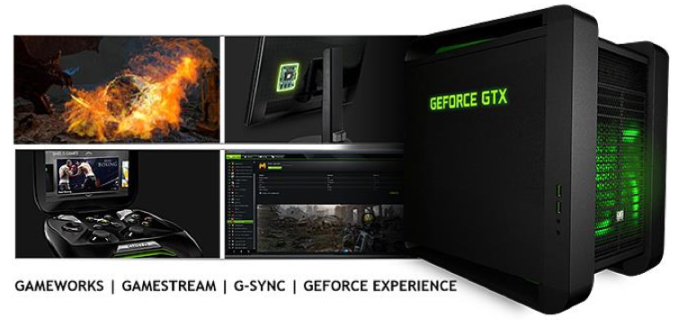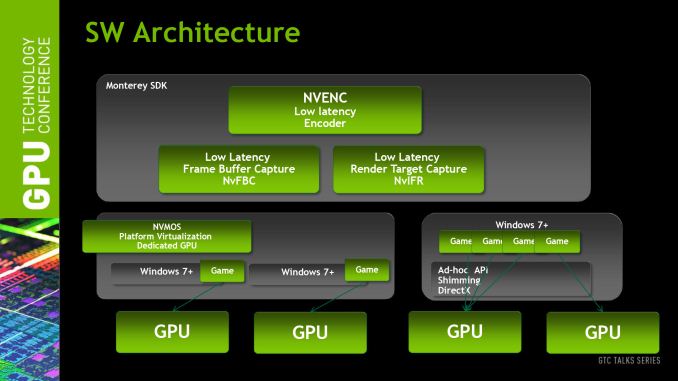The NVIDIA GeForce GTX 750 Ti and GTX 750 Review: Maxwell Makes Its Move
by Ryan Smith & Ganesh T S on February 18, 2014 9:00 AM ESTMaxwell’s Feature Set: Kepler Refined
To start our look at the Maxwell architecture, we’ll start with a look at the feature set, as this will be the shorter and easier subject to begin with.
In short, Maxwell only offers a handful of new features compared to Kepler. Kepler itself was a natural evolution of Fermi, further building on NVIDIA’s SM design and Direct3D 11 functionality. Maxwell in turn is a smaller evolution yet.
From a graphics/gaming perspective there will not be any changes. Maxwell remains a Direct3D 11.0 compliant design, supporting the base 11.0 functionality along with many (but not all) of the features required for Direct3D 11.1 and 11.2. NVIDIA as a whole has not professed much of an interest in being 11.1/11.2 compliant – they weren’t in a rush on 10.1 either – so this didn’t come as a great surprise to us. Nevertheless it is unfortunate, as NVIDIA carries enough market share that their support (or lack thereof) for a feature is often the deciding factor whether it’s used. Developers can still use cap bits to access the individual features of D3D 11.1/11.2 that Maxwell does support, but we will not be seeing 11.1 or 11.2 becoming a baseline for PC gaming hardware this year.
On the other hand this means that for the purposes of the GeForce family the GTX 750 series will fit in nicely into the current stack, despite the architectural differences. As a consumer perspective is still analogous to a graphics perspective, Maxwell does not have any features that will explicitly set it apart from Kepler. All 700 series parts will support the same features, even NVIDIA ecosystem features such as GameWorks, NVENC, and G-Sync, so Maxwell is fully aligned with Kepler in that respect.
At a lower level the feature set has only changed to a slightly greater degree. I/O functionality is identical to Kepler, with 4 display controllers backing NVIDIA’s capabilities. HDMI 1.4 and DisplayPort 1.2 functionality join the usual DVI support, with Maxwell being a bit early to support any next generation display connectivity standards.
Video Encode & Decode
Meanwhile turning our gaze towards video encoding and decoding, we find one of the few areas that has received a feature upgrade on Maxwell. NVENC, NVIDIA’s video encoder, has received an explicit performance boost. NVIDIA tells us that Maxwell’s NVENC should be 1.5x-2x faster than Kepler’s NVENC, or in absolute terms capable of encoding speeds 6x-8x faster than real time.
For the purposes of the GTX 750 series, the impact of this upgrade will heavy depend on how NVENC is being leveraged. For real time applications such as ShadowPlay and GameStream, which by the very definition can’t operate faster than real time, the benefit will primarily be a reduction in encoding latency by upwards of several milliseconds. For offline video transcoding using utilities such as Cyberlink’s MediaEspresso, the greater throughput should directly translate into faster transcoding.
The bigger impact of this will be felt in mobile and server applications, when GM107 makes its introduction in those product lines. In the case of mobile usage the greater performance of Maxwell’s NVENC block directly corresponds with lower power usage, which will reduce the energy costs of using it when operating off of a battery. Meanwhile in server applications the greater performance will allow a sliding scale of latency reductions and an increase in the number of client sessions being streamed off of a single GPU, which for NVIDIA’s purposes means they will get to increase the client density of their GRID products.
Speaking of video, decoding is also receiving a bit of a lift. Maxwell’s VP video decode block won’t feature full H.265 (HEVC) support, but NVIDIA is telling us that they will offer partial hardware acceleration, relying on a mix of software and hardware to decode H.265. We had been hoping for full hardware support on Maxwell, but it looks like it’s a bit premature for that in a discrete GPU. The downside to this is that the long upgrade cycle for video cards – many users are averaging 4 years these days – means there’s a good chance that GTX 750 owners will still be on their GTX 750 cards when H.265 content starts arriving in force, so it will be interesting to see just how much of the process NVIDIA can offload onto their hardware as it stands.
H.265 aside, video decoding overall is getting faster and lower power. NVIDIA tells us that decoding is getting a 8x-10x performance boost due to the implementation of a local decoder cache and an increase in memory efficiency for video decoding. As for power consumption, combined with the aforementioned performance gains, NVIDIA has implemented a new power state called “GC5” specifically for low usage tasks such as video playback. Unfortunately NVIDIA isn’t telling us much about how GC5 works, but as we’ll see in our benchmarks there is a small but distinct improvement in power consumption in the video decode process.












177 Comments
View All Comments
Mondozai - Wednesday, February 19, 2014 - link
USA in recession? You are either ignorant or use your own home-cooked economics for "special" people like yourself.As for consoles. Sure you can get low-end cards for cheaper sums a PC but people buy consoles for their games, simplicity and the fact that they are increasingly multimedia machines for a low cost.
These factors will not change with these new cards.
Yojimbo - Wednesday, February 19, 2014 - link
I thought I remember reading a headline a while back that said Sony or Microsoft or both were not planning on selling their hardware for a loss this time...madmilk - Tuesday, February 18, 2014 - link
The launch PS3 cost over $800 to manufacture, and Sony lost something like $3 billion in the first two years from hardware sales even though the PS3 wasn't even selling that well. To a lesser extent, Microsoft had the same problem with the Xbox 360. Of course Sony and Microsoft would go for cheaper, mid-range off-the-shelf components this time around. No one wants to make the same mistake twice.Antronman - Tuesday, February 18, 2014 - link
Wow. What do they think, everybody here is an OC pro who has/had world records and has a monster closed loop browsing/gaming/work setup? I don't give a damn about lower power consumption if it means I have to OC the balls off the card!moozoo - Tuesday, February 18, 2014 - link
Please include at least one fp64 benchmark in the compute section.It is great that you found out and reported the fp64 ratio.
Its a pity there isn't at least one low power low profile card with good DP Gflops (at least enough to beat the CPU and form a compelling argument to switch API's)
At work we only get small form factor PCs, and asking for anything that looks different ends in politics.
Ryan Smith - Thursday, February 20, 2014 - link
For the moment FP64 data is available via Bench. This being a mainstream consumer card, it's purposely not built for high FP64 performance; FP64 is there for compatibility purposes rather than being able to do much in the way of useful work.This is a purposeful market segmentation move that won't be going anywhere. So cards such as the 750 Ti will always be very slow at FP64.
jrs77 - Tuesday, February 18, 2014 - link
Now we need a manufacturer to release a GTX750 with single-slot cooler.koolanceGamer - Tuesday, February 18, 2014 - link
While all of this "low power" stuff is a little boring to me (not that anything is really pushing the high end card) I hope that in the not too distant future even the video cards like the 780/Titan will be able to be powered by the PCI alone.I would love to do a gaming build with a PCI based SSD and no cables coming off the video cards, it would be so clean!
EdgeOfDetroit - Tuesday, February 18, 2014 - link
Well I want laser light circuit cables. So much faster than copper and they would look so clean, you wouldn't even know there was a cable there unless you put your hand into the laser beams to see the pretty lights...... Ahh crap another BSOD, these laser cables suck!
Devo2007 - Wednesday, February 19, 2014 - link
Starting to wonder what a good card to replace a GTX 560 Ti would be (that's still relatively affordable). Would I have to step up to something like the R9 270 or GTX 760 cards to make things worthwhile? The power savings of the GTX 750 Ti aren't really a big factor as I'm currently using a 650w PSU, but I also don't want to spend a ton of money.